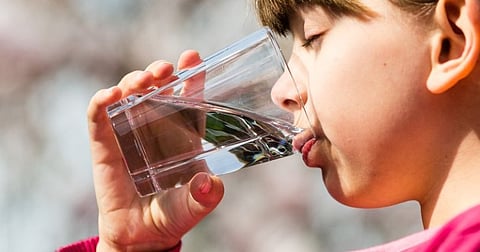
- Home
- Live Blog
- Breaking News
- Top Headlines
- Cities
- NE News
- Sentinel Media
- Sports
- Education
- Jobs

Adding fluoride to water has been common practice during a variety of countries, together with India. In low concentrations, it will facilitate to stop tooth decay and even strengthen bones, however going on top of which will have the other impact. Scientists have developed a transportable and easy device which will measure fluoride concentration accurately using only a few drops of water, and help address contamination in drinking water, said researchers from the Ecole Polytechnique Federale de Lausanne (EPFL) in Switzerland.
In low concentrations below 1.5 milligrams per litre (mg/L) -- fluoride will facilitate to stop tooth decay and even strengthen bones, as per the study published within the Journal of the American Chemical Society (JACS). However, going above that can have the other impact, inflicting serious dental and bone disease, particularly in youngsters and developing fetuses. To stay things under control, the WHO has set 1.5 mg/L because of the most limit for fluoride in drinking water.
“To determine whether drinking water is safe we'd like to observe fluoride in water at the level of parts-per-million (ppm),” said Kyriakos Stylianou from EPFL. “Around 1-1.5 ppm is good for teeth, however in several countries, the water sources have concentrations above 2 ppm can cause serious health problems,” he added.
However, measuring fluoride at such low concentrations with adequate accuracy is pricey and needs a well-equipped chemical research lab. Because of this, fluoride contamination in water affects a variety of developing countries these days, and even elements of developed countries. Scientists have currently designed a tool which will accurately measure fluoride concentrations using solely a number of drops of water -- even with low-level contamination -- resulting to a simple change in color brightness. The device, named SION-105, is transportable, significantly cheaper than current ways, and might be used on-the-scene by nearly anyone, researchers said.
The key to the device is that the style of a unique material that the scientists synthesized, they said. The material belongs to the family of “metal-organic frameworks” (MOFs), compounds made up from a metal particle or a cluster of metal ions connected to organic ligands, therefore forming one-, two-, or three-dimensional structures. Because of their structural skillfulness, MOFs can be used in an ever-growing list of applications, eg separating petrochemicals, detoxing water, and getting hydrogen or even gold out of it. SION-105 is luminescent by default but darkens when it encounters fluoride ions.
“Add a number of droplets of water and by monitoring the color change of the MOF one will say whether or not it's safe to drink the water or not,” said Mish Ebrahim, the first author of the analysis paper. “This will currently be done on-the-site, with none chemical experience,” Ebrahim said. The researchers used the device to see the fluoride content in numerous groundwater samples from Vietnam, the United Arab Emirates, and Saudi Arabia.
The data corresponded all right in comparison to measurements made using ion chromatography, a standard method for measuring fluoride concentration in water. “This comparison showcases the performance and reliability of SION-105, which, including the portability and ease-of-use of the device, make it an awfully easy resolution for water sampling in remote areas where frequent fluoride concentration monitoring is predominant,” said Stylianou.